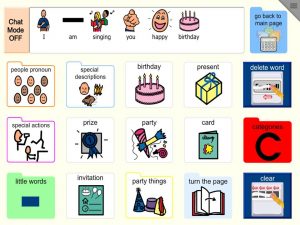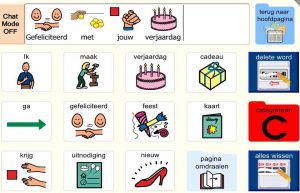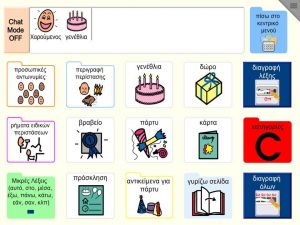Note from Jane:
I can’t thank Mary-Louise Bertram enough for writing this fabulous guest post! I saw her put this explanation on Facebook and begged her to turn it into a blog post – which she did. Mary-Louise is a fabulous AAC person, very knowledgeable and skilled. She is one of my favourite people to go to for ideas and support – and I’m delighted she agreed to post this here.
As professionals with a keen interest in AAC, we often find ourselves trying to explain to people why we do modelling or Aided Language Stimulation – and why THEY should do it too!
Many of us find it helps to share the analogy that we talk to typically developing babies for 18 months or more before they talk back. We try to support people who are new to AAC and Aided Language Stimulation by saying that if we immerse the child in language, they will begin to learn to understand it. If we have a long period of ongoing, rich, engaging, and dynamic immersion they will begin to use language expressively. We know this is how typically developing children learn language. We know immersion is how people learn foreign languages best. We know immersion in a symbol rich using consistent and powerful strategies, including Aided Language stimulation, is how children with Complex Communication Needs learn to use AAC. We know this, but often we need reminders of what it may feel like for these early AAC learners.
When I’m explaining to parents and professionals why we model AAC around the AAC learner, I have found it can be helpful to show these images.

English page (from PODD in Tobii DynaVox Compass)
Here, with this first image of an English AAC pageset, I explain that if you or I lost our voice tomorrow we would be able to use this AAC page/system because we have one skill – we can read the labels. We may have never seen the symbols before, we may feel stressed by using them, but our saving grace is that we can read the labels.
Many AAC learners do not have the literacy skills to be able to read the label. Some may have some early literacy skills, though, and they could use those to figure out some of the text.

Dutch page
Here we see a page of a Dutch AAC page set. If an AAC learner has never seen this before and has no experience with this symbol set but has some early literacy skills, he or she might get some clues about the labels. For example, he may be able to use those early literacy skills to figure out the cell for ‘I’ or ‘go’, which is what you and I are doing right now. Early literacy skills aren’t going to help that user with the more complex labels, though.
As we reflect on how you and I, with our competent verbal language skills and our strong literacy skills feel when confronted with this AAC page, it helps us to understand how an AAC learner might feel. It helps us to understand that we shouldn’t we really expect immediate, ‘appropriate’ expressive use of robust AAC systems by AAC learners with early literacy skills.

Greek page
Here is the final image for us to reflect on. For the overwhelming majority of our AAC learners, when they first see an AAC system it looks like this. This final image is a page from a Greek AAC page set. For an AAC learner with minimal or very emergent literacy, this picture shows us what their AAC may look like to them. They do not yet have the literacy skills to read the labels. They do not yet have the literacy skills to even get some clues from the labels. This is the position that you are in now as you look at this image – you have no clues from the labels to support your expressive use of the AAC (unless you can read Greek!).
So, if you and I had to use this page tomorrow what are the two ways we would learn to use it?
1) People around us would need to use it to talk to us. They would need to talk to us with this system and as they did so they would map spoken English language onto the symbols. In meaningful and engaging conversation, in gentle and pressure-free environments, our communication partners would need to casually point to the symbols as they spoke the label in English, point to the symbol and say the word as they played with us, point to the symbol and say the word as they chatted with other people around us. Pointing to the symbols and saying the label as much as possible so we could start to map language onto these symbols and squiggles.
2) As AAC learners using this page, we would need to babble. We are in an immersion environment and people are using this to talk to us but we need to explore how to talk back. We would need to touch the cells and either hear voice output in spoken language that we understand – or, if this was light tech paper based AAC, we would need to hear people around us speaking words each time they see us touch the symbols. As we look at this page with all those squiggles that we cannot read, we are going to need to try it all out. We are going to need time to babble with it, to ‘play’ with it, and lots of time to use it in a pressure free setting with people we feel comfortable with.
This is how our AAC learners learn their AAC language. If they cannot read the label, it all ‘looks Greek to them’. This means we have to 1) use it to talk to them – A LOT and 2) let them babble and hear responses to their babbling.
This Greek AAC page truly helps us to understand that we shouldn’t expect immediate, ‘appropriate’ expressive use of robust AAC systems by AAC learners with minimal or early literacy skills. If we would feel some performance anxiety when confronted with this – just imagine how someone who is just learning to communicate might feel!
In the beginning, a large part of learning to use AAC is about language and mapping spoken language onto symbols. It not about performance, it is not about recognising symbols. It’s about language. So, let us put ourselves in our AAC learners shoes for a moment. Have a look at your own AAC learner’s system. Aren’t we so incredibly lucky that we can read the labels?
Mary-Louise Bertram


Cathy Hurman
jane
radicielena
Kim Pose
jane